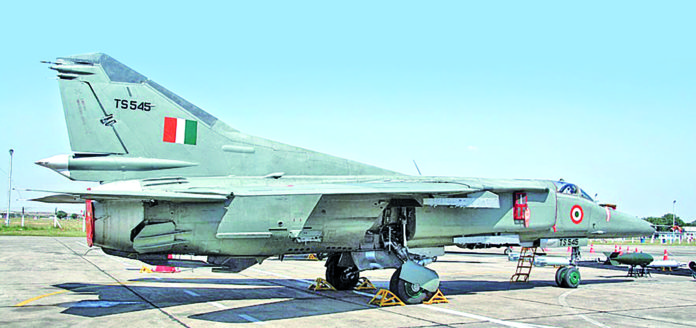BrahMos Land and Air Platforms
Two variants of supersonic cruise missile BrahMos were successfully tested, on 17 December, to check their capability to hit targets with precision and accuracy.
A land-attack version of the missile was test-launched from a mobile autonomous launcher at Launch Pad-3 of the Integrated Test Range (ITR) at Chandipur. Earlier on May 22, 2019, IAF had successfully tested the missile against a land-based target in the Car Nicobar Islands region.
In the second test on 17 December, the air force variant was fired when a fighter jet of the IAF flew from Kalaikunda airbase and launched the missile towards an air-borne target over the Bay of Bengal. This was the third such live launch of the weapon and with this launch, the integration of the missile on Su-30MKI aircraft, is complete.
The air launched BrahMos missile is a 2.5 ton supersonic air to surface cruise missile with ranges close to 300 km. The IAF became the first Air Force in the world to have successfully fired an air launched trisonic-class surface attack missile of this category on a sea target on 22 November2017. This was followed by a second live launch over a land target on 22 May 2019.
The software development and integration of weapon of the aircraft was undertaken by the IAF engineers while HAL carried out complex mechanical and electrical modifications on aircraft.
The BrahMos missile provides Indian Air Force a much desired capability to strike form large stand-off ranges on any target at sea or on land with pinpoint accuracy by day or night and in all weather conditions. The capability of the missile coupled with the high performance of the Su-30MKI aircraft gives the IAF a strategic reach and allows it to dominate the battle fields over land and sea.
The BrahMos missile is a medium-range ramjet supersonic cruise missile capable of being launched from submarines, warships, fighter jets or land. The 2.5-tonne missile has a strike range of nearly 300 kilometres. The first extended version of the missile with a strike range of 450 km was successfully tested on 11 March 2017.
A shorter range land-attack version of the BrahMos was earlier successfully test-fired from the ITR at Chandipur on 30 September 2019.
Similarly, the IAF had conducted successful trials of BrahMos missiles from Trak Island in Andaman and Nicobar Islands on 22 October 2019.
Quick Reaction SAM System
Quick Reaction Surface to Air Missile System (QRSAM) developed by DRDO was successfully flight-tested, on 23 December, from the Integrated Test Range in Odisha’s Chandipur, with full configuration in deployment mode intercepting the target in mid-air. The test met all mission objectives. The missile successfully engaged the aerial target establishing its capability.
QRSAM weapon system, which operates on the move, comprises of fully automated Command and Control System, Active Array Battery Surveillance Radar, Active Array Battery Multifunction Radar and Launcher. Both radars are four walled having 360-degree coverage with search on move and track on move capability. The system is compact with minimum number of vehicles for a firing unit. Single stage solid propelled missile has mid course inertial navigation system with two-way data link and terminal active seeker developed by DRDO.
With this mission, the developmental trials of the weapon system are successfully completed and the weapon system is expected to be ready for induction by 2021.
Pinaka Guided Rocket System Tested
An upgraded version of Pinaka guided rocket system was successfully test-fired from base on Odisha coast, on 19 December, from Integrated Test Range, Chandipur, off the Odisha coast. The missile was fired from Pinaka launcher system in deployment configuration.
The mission achieved all the objectives including enhancing the range, accuracy and sub-system functionality.
Pinaka is an artillery missile system capable of striking into an enemy territory up to a range of 75 km with high precision.
The Pinaka Mk-II rocket is modified as a missile by integrating with the navigation, control and guidance system to improve the end accuracy and enhance the range.
The navigation system of the missile is also aided by the Indian Regional Navigation Satellite System (IRNSS) also called as NAVIC.
The missile system has been jointly developed by various Defence Research and Development Organisation (DRDO) laboratories viz Armament Research and Development Establishment (ARDE), Research Centre Imarat (RCI), Defence Research and Development Laboratory (DRDL), Proof & Experimental Establishment (PXE) and High Energy Materials Research Laboratory (HEMRL).
=============
Philippines May Induct BrahMos in 2020
The Philippines is set to become the first country to buy the BrahMos cruise missile jointly developed by India and Russia, with New Delhi and Manila focusing on price negotiations with the aim of concluding a deal in 2020
The contract signing for the medium-range ramjet supersonic BrahMos cruise missiles, for coastal defence missions of the Philippine Army, may take place by the early part of 2020, Philippines Department of National Defence (DND) Secretary Delfin Lorenzana said on 16 December.
The cost of the system will be the key factor in Manila’s decision on the number of units to be purchased to equip the Philippines Army’s first Land Based Missile System Battery, which was raised and activated in October. Lorenzana said that Philippines would acquire two batteries in a government-to-government deal. A missile battery is equivalent to three mobile autonomous launchers with two or three missile tubes each.
India has been in talks with several countries, including Thailand, Indonesia and Vietnam, over the past few years to sell them land and sea-based versions of the supersonic cruise missile.
Though India has offered a $100 million line of credit to the Philippines for defence purchases, Manila is exploring the option of acquiring the BrahMos system with its own funds to be allocated in the next budget.


















